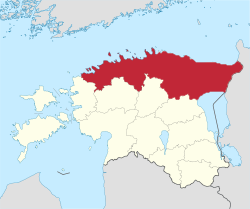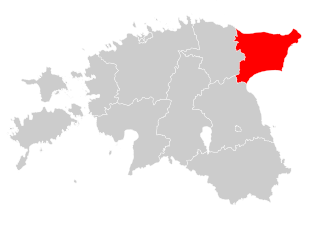
Ida-Viru County is one of 15 counties of Estonia. It is the most north-eastern part of the country. The county contains large deposits of oil shale - the main mineral mined in Estonia. Oil shale is used in the production of shale oil and in thermal power plants. The capital of the county is the town of Jõhvi which is administratively united with the Jõhvi Parish; nevertheless, Narva is the largest town in the county in terms of population and at the same time the third largest city in Estonia after Tallinn and Tartu.

Jõgeva County is one of 15 counties of Estonia. It is situated in eastern part of the country and borders Ida-Viru County to the north-east, Lake Peipus to the east, Tartu County to the south, Viljandi County to the south-west, Järva County to the north-west and Lääne-Viru County to the north.

Lääne-Viru County is one of 15 counties of Estonia. It is in northern Estonia, on the south coast of the Gulf of Finland. In Estonian, lääne means western and ida means east or eastern. Lääne-Viru borders Ida-Viru County to the east, Jõgeva County to the south, and Järva and Harju counties to the west. In January 2013, Lääne-Viru County had a population of 58,806: 4.5% of the population in Estonia.

Kohtla-Järve [kotla-jærve] is a city and municipality in northeastern Estonia, founded in 1924 and incorporated as a town in 1946. The city is highly industrial, and is both a processor of oil shales and is a large producer of various petrochemical products. During the 1944–1991 Soviet occupation, large numbers of immigrant workers from Russia and other parts of the former USSR were brought in to populate the rapidly growing city. The population in the Kohtla-Järve area which had been, as of 1934 census, over 90% ethnic Estonian, became overwhelmingly non-Estonian in the second half of the 20th century. According to more recent data 21% of the city's population are ethnic Estonians; most of the rest are Russians. Kohtla-Järve is the fifth-largest city in Estonia in terms of population.

Aa is a village in northern Estonia, on the southern coast of the Gulf of Finland in the eastern part of the Lüganuse Parish of Ida-Viru County, 10 km (6.2 mi) from Lüganuse. Part of the village, including the Aa manor house, is situated on the North Estonian limestone bank.

Kiviõli is an industrial town in Ida-Viru County, Estonia, established in 1922. The main industry in the town is oil shale mining, which gives the town its name.

Northern Estonia is a geographical region of Estonia, consisting of the three northernmost counties - Harju County, Ida-Viru County and Lääne-Viru County. The largest towns of Northern Estonia are Tallinn, Narva, Kohtla-Järve and Rakvere. Northern Estonia is the most populous area in Estonia, with 60.3% of the population living there.
Alajõe is a village in Ida-Viru County, in northeastern Estonia. It is located on the northern shore of Lake Peipus. Alajõe is the administrative centre of Alutaguse Parish. In 2000 the village had a population of 147.
Karjamaa is a village in Alutaguse Parish, Ida-Viru County, in northeastern Estonia. It is located on the northern shore of Lake Peipus. Karjamaa has a population of 30.
Katase is a village in Alutaguse Parish, Ida-Viru County, in northeastern Estonia. It's located on the northern shore of Lake Peipus. Katase has a population of 49.
Remniku is a village in Alutaguse Parish, Ida-Viru County, in northeastern Estonia. It is located on the northern shore of Lake Peipus. Remniku had a population of 59 in 2000.
Uusküla is a village in Alutaguse Parish, Ida-Viru County, in northeastern Estonia. It is located on the northern shore of Lake Peipus. Uusküla has a population of 69.
Linna is a village in Jõhvi Parish, Ida-Viru County in northeastern Estonia. It is located just east of the town of Jõhvi, around the Tallinn–Narva railway, and is bordered by the Tallinn–Narva road (E20) to the north. As of the 2011 census, the settlement's population was 28.
Sinimäe is a small borough in Narva-Jõesuu municipality, Ida-Viru County in northeastern Estonia. At the 2011 Census, the settlement's population was 319, of which the Estonians were 100 (31.3%). Prior to the 2017 administrative reform of local governments, it was located in Vaivara Parish.
Smolnitsa is a village in Alutaguse Parish, Ida-Viru County, in northeastern Estonia. It is located on the northern shore of Lake Peipus. Smolnitsa has a population of 19.
Matka is a village in Lüganuse Parish, Ida-Viru County, Estonia.
Satsu is a village in Lüganuse Parish, Ida-Viru County, Estonia.

Voka is a village in Toila Parish, Ida-Viru County, Estonia.
Erra is a small borough in Lüganuse Parish, Ida-Viru County, in northeastern Estonia. As of the 2011 census, the settlement's population was 130.

Electoral district no. 7 is one of the 12 multi-member electoral districts of the Riigikogu, the national legislature of Estonia. Established in 1992 when the Riigikogu was re-established following Estonia's independence from the Soviet Union, the district was abolished in 1995 following the re-organisation of electoral districts only to be re-established in 2003. It is conterminous with the county of Ida-Viru. The district currently elects seven of the 101 members of the Riigikogu using the open party-list proportional representation electoral system. At the 2019 parliamentary election it had 56,836 registered electors.










